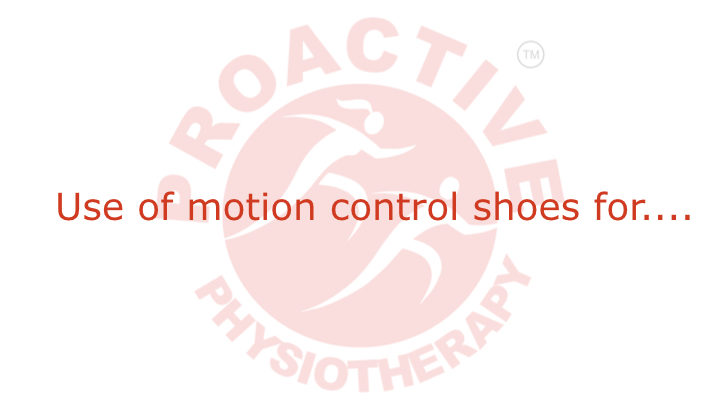Use motion control shoes for….
The benefits of Motion control running shoes have been shown, in numerous scientific studies since past decaded. The literature shows that it is use to reduce rearfoot pronation, reduce internal tibial rotation, reduce longitudinal arch flattening and reduce fatigue in lower extremity muscles.
Motion control running shoes are those running shoes which contain higher durometer dual-density rearfoot midsole constructions, more stiff heel counters, and wider soles especially within the midfoot region of the running shoe ( see image below)

What the research indicates……..
In 2007, Cheung et. found that rearfoot pronation was higher in 25 female runner when running in neutral shoes versus motion control shoes in both a non-fatigue and fatigued condition. However, The authors showed again in 2009 that motion control running shoes may facilitate a more stable temporal activation of the vastus medialis obliquus during running.
The author did the study again [in a 2011] Cheung and Ng found that, in 20 female runners, the resistance of the peroneus longus and tibialis anterior muscles to fatigue was improved in runners with excessive rearfoot pronation when they ran in motion control shoes versus when they ran in neutral running shoes (3).
In 2011, Rose et al also demonstrated that the total transverse plane tibial rotation measured with a 3D video analysis system in 24 subjects was significantly less when the runners were wearing motion control running shoes versus wearing neutral running shoes.(4).
Again In 2013, Lilley et al studied 15 mature (ages 40-60 years) and 15 young (ages 18-25 years) female runners with force plates and 3D motion analysis and found that motion control running shoes significantly reduced both peak rearfoot eversion and knee internal rotation in both mature as well as young female runner groups (5).
However,In 2017, Langley et al found in research that motion control running shoes reduced medial longitudinal arch flattening and midfoot-rearfoot eversion (6).
To sum up, Jafarnezhadgero et al.found running in anti-pronation running shoes, compared with neutral running shoes, produced lower peak moments and powers in lower limb joints and better control of rearfoot eversion[1].
Closing thoughts:
Hence, there are six scientific research studies that we have found which clearly indicates that motion control running shoes do to reduce the magnitude of pronation motion, internal tibial rotation motion, longitudinal arch deformation and improve muscle fatigue in runners. From all of the scientific research, we are very confidently state that the design features of motion control running shoes do actually work to reduce pronation in runners. Moreover, it may be used in selected runners. It is as a valid method and not only to treat running injuries, but also possible to prevent pronation-related running injuries.
Referance:
- Jafarnezhadgero A, Alavi-Mehr SM, Granacher U (2019) Effects of anti-pronation shoes on lower limb kinematics and kinetics in female runners with pronated feet: The role of physical fatigue. PLoS ONE 14(5): e0216818.
- Cheung RTH, Ng GYF: Efficacy of motion control shoes for reducing excessive rearfoot motion in fatigued runners. Phys Ther Sport, 8:75-81, 2007
- Cheung RT, Ng GY: Motion control shoe delays fatigue of shank muscles in runners with “overpronating” feet. American J Sports Med. 38(3):486-491, 2010
- Rose A, Birch I, Kuisma R: Effect of motion control running shoes compared with neutral shoes on tibial rotation during running. Physiotherapy. 97(3):250-255, 2011
- Lilley K, Stiles V, Dixon S: The influence of motion control shoes on the running gait of mature and young females. Gait & Posture. 37(3):331-335, 2013
- Langley B, Cramp M, Morrison S: The influence of motion control, neutral and cushioned running shoes on foot kinematics. Footwear Science. 10;9(S1):S22-23, 2017
- image courtesy Google




Leave a Reply
Want to join the discussion?Feel free to contribute!